NESTA REPORT JUNE 2003
Jonathan Hare, FEL0005
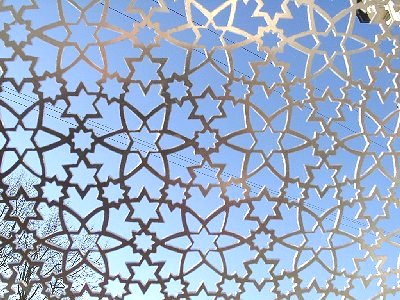

INTRODUCTION - Recollections of Dream Time
NESTA supports me via a Fellowship 1 day/week for 4 years. Even though this is equivalent to just under a year of full time support I have managed to cover a lot of ground. I am very grateful to NESTA.
I have been able build into my diary blocks of NESTA 'days' rather than just a 'day a week' and this has made much better use of my time. I am fortunate indeed that my NESTA fellowship enables me to explore and dream up new avenues to investigate. My original proposal, which was quite open-ended, enabled me to explore a few key areas:
i) salary and equipment for invention and experimentation,
ii) exploration of meditation (teachings and courses) and lateral thinking
iii) resources to explore other creative areas such as drawing and painting
For a busy / active person it really is great to have this valuable thinking and dream time. That this is wanted and valuable to others too must be so as NESTA has recently launched their Dream Time Award !
There are powers and thoughts within us, that we know not till they rise,
Through the stream of conscious action from where the Self in secret lies.
But when Will and Sense are silent, by the thoughts that come and go,
We may trace the rocks and eddies in the hidden depths below.
Recollections of Dreamland, James Clerk Maxwell.
RECENT WORK
A number of NESTA projects are described below:
The shake-a-gen
This may be the worlds simplest electrical generator. It evolved during a period thinking about designs for generators to harness wave power (inspired by my earlier work on Leonardo de Vinci (2002)). This lead to a very simple design which has now become a CSC workshop (although this was not the original aim). The design has been published in an Institute of Physics Journal (with credit to NESTA) as well as in Science Year's - 'Little Book of Experiments'. Other innovations have developed from the original prototype.
click here for details of the Shake-a-gen
click here for details of the Shake-a-gen storage device
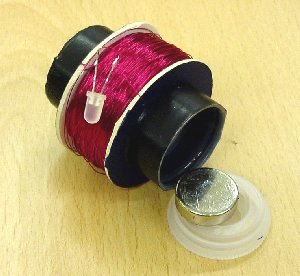
Publications:
The shake-a-gen, Physics Education, IOP press, Sept. 2002, p.436-439.
The Little Book of Experiments, Planet Science (Science Year), Hodder & Stoughton, 2002. ISBN 0-340-87591-7.
Interest via the web, e-mails and telephone conversations have been shown in the shake-a-gen. For example David Birckett-St-Lauvent, a leader of a current North Pole expedition, contacted me to see if such a device could power their laptop computers on route. Since the prototype was made it has been brought to my attention that a very similar device already exists commercially. Despite this I am happy with the way things have turned out as it forms a great educational tool and has now become a popular CSC workshop. So far, perhaps a 100 of these shake-a-gen's have been made by children in schools.
click here for details of the childrens Shake-a-gen workshops
2) PIC Work
In my last report I mentioned that I intended to get to grips with a fascinating new area of technology called PIC's. These are small integrated circuits (chips) that have the whole architecture of a simple computer within them. It is possible to make use of just a single chip device and a few other components to make complex, extremely interesting and potentially useful devices. In fact PIC's are already to be found in many devices we use including car ignition systems, burglar alarms, mobile phones, medical instruments ... etc.
Although these devices are widespread the secret to making use of their potential is not only in knowing how to wire them up but also how to program them. I have used NESTA time to learn about the devices and to learn how to program them as well as make a few prototypes. NESTA money was used to buy a PC, software and hardware to program them as well as an UV eraser to re-use chips and help in circuit development.
In the first year of my fellowship I designed and built a Moon Clock (2001) - a device that showed the phase of the Moon using a display made up of LED lights. This device used 5 integrated circuits as well as numerous other components and required a multi-way wiring loom from circuits to display.
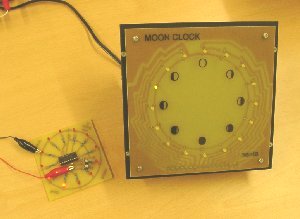
As an exercise to show the power of the PIC chip, I decided to build a simpler MK2 PIC Moon clock. The latest PIC version is so simple it only has the LED's, battery and a couple of other components to form a much more compact and pleasing device. All the 'hard work' of the previous design (done using various components) has been superseded / replaced in the MK2 version by the software. This I had to develop and program into the PIC chip. I am delighted with the results and it has fired me up to make use of this amazing technology further. This has been a really great long-term use of my NESTA fellowship. I am aiming for the design to be published as a beginners project in a popular electronics journal / magazine (Everyday Practical Electronics).
3) Book Idea
I have completed the first draft of a book entitled 'Starting Electronics'. Rufus Marsh (NESTA Fellow) very kindly looked at the draft and made a number of important suggestion and changes and these need to be incorporated into the work before it can go to the next stage.
4) TRUST - a sculpture
Recent world developments have highlighted the differences (and similarities) between East and West and the paranoia shown by each side. I have been working on a sculpture to look at some of these fundamental problems: i) in terms of the many types of people that occupy this surface-limited Earth and secondly ii) the mathematical laws that describe the same space sharing problem from a purely topological perspective.
The sculpture consists of a complex, many polygon Arabic (Islamic) pattern based on a image of a stone lattice-work window I discovered in the literature. I took the basic pattern, extended it and used this modified design as the basis of the sculpture. The pattern is so delicate that it is not possible to cut the pattern out with a fret saw so this was done using needle files. 40 x 15cm sheet metal was used as the medium. This took a total of about 60 hours to cut out / file. It is planned that the piece will sit vertically on a hemi spherical wooden base.
I have used the pattern to try and express, both on the one hand the mathematical laws that bind the shapes together, and also the laws that bind us all as humans together. Details of the mathematics / philosophy will be added to my web site as soon as possible.
The sculpture shows that it is indeed possible to cover 'a surface' with many polygons ('types of people') but that, most importantly, the pattern created can in fact be the more beautiful because of the diversity.
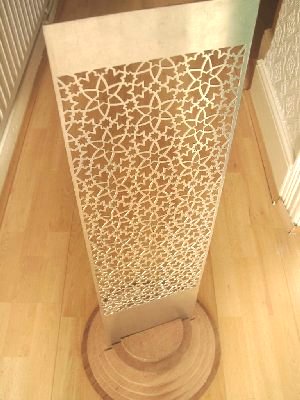
5) Meditation Courses
I asked NESTA for support in this area because I felt that the practice of meditation reveals the 'essential' mind behind our actions and so in fact is at the heart of the creative process. There often seems to be confusion (by those that are not familiar with mediation) over what is precisely meant by the term. From my point of view meditation is the name given to what is happening when one simply leaves the mind undistracted. Now although thoughts and concepts appear as the natural activity of the mind it is also possible to let this activity subside while still maintaining a great awareness and clarity. This is meditation.
From this vantage point one can view the minds aspirations and motivations. It is also possible to start to be aware of process that might be unproductive, a waste of time, or even to be able to reduce those that produce negativity. Meditation is therefore at the heart of ones development and creativity.
Meditation courses attended over the fellowship have been the 'Bringing The Mind Home', the 'Meditation Matters' courses (Lewes, Sussex 2000-1), 'The Path to Enlightenment' (a 5 day teaching by H. H. Dalai Lama, France 2000) as well as starting the Rigpa Stream 1, year-long course. I also attended a 10 day (2003) Easter Retreat with Sogyal Rinpoche (Rigpa).
To try and communicate what has been gained over these periods of practice / study I have tried to express some common themes through my paintings. See the paintings section below and in particular the footnote descriptions under each.
6) Painting and Drawing
Although more time in the last year of the fellowship is planned for pursuing painting I have managed to complete a number of paintings and drawings in this third year. One theme is to express what has been learnt and understood in the meditation courses. The First image shown below (Meditation (1998) was a first attempt at this and I have used NESTA time to build on this. Distraction (π-chair) shows a meditation stool surrounded by multi coloured lights. The picture shows the many distracting thoughts every meditator has to let 'drop' during the meditation. Beads obscure the thread (2003) tries to deal with the fundamental nature of our minds.
Another painting - Mirrors on a Thailand Temple (2003) - is based on the wonderful light both bright and scattered in all directions by the tiny mirror decorations adorning Thai temple walls. I also hope to do a series of paintings and use them in a talk about light.
click here for details of NESTA Paintings by JPH
Drawings
While filming Rough Science 3 (2002) in the South Island of New Zealand last year I took time off to sketch the Maori designs I saw in the Jade workshops along the west coast. In particular I studied the Maori spiral designs to inspire my own sketches and also used Maori woodcuts to design (at least on paper) my own picture / mirror frame (above).
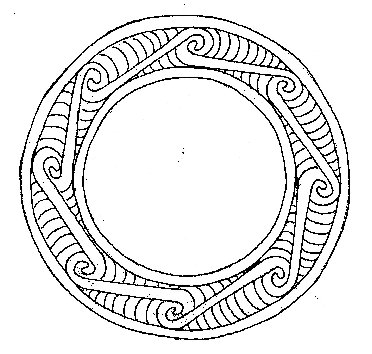
|
7. Dream Time Referee
In Sept 2002 I was asked by NESTA to evaluate 12 science and technology applications for the years NESTA's Dream Time awards. This was extremely rewarding and interesting and I was delighted to be able to contribute a little.
THE FUTURE
I plan to spend more time gathering the various experiences I have had over the last couple of years to develop a number of paintings based on Maori Art and design, exploring light and nature (Ice, glaciers etc) and meditation. I also want to pursue sculpture, perhaps using stone (Jade or flint) and metal. I think my artistic, science communication and technical skills merge in an interesting way in this area.
I have recently purchased frames for the paintings and it is hoped that at some stage near to the end of the Fellowship I can hold an exhibition of some of these as well as the other Fellowship activities.
I would also like to attend a PIC course as this technology seems to change and develop as fast as the weather ! As usual I will also be investigating a number of other ideas.
Jonathan Hare, June 2003
home | diary | whats on | CSC summary | latest news